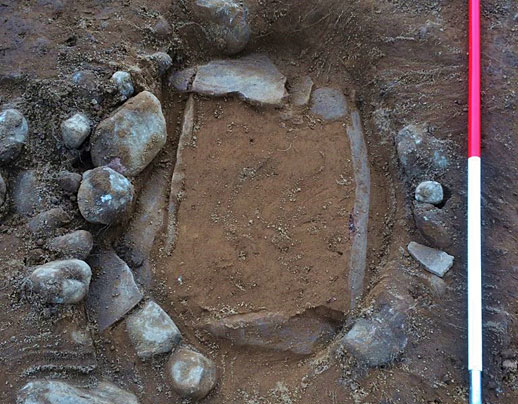The Loch Ness Monster – or its ancestor – may have been spotted more than 1400 years ago. It’s said that St Columba, on a Christian pilgrimage to convert the native inhabitants, had an encounter with a large “water beast” in 564 AD.
But a new discovery here goes even further back … some 4000 years in fact. Archaeologists have located an ancient grave on the site of a new development in Drumnadrochit, at the head of Urquhart Bay, on the northern shore of Loch Ness.
This is the second such finding, following on from the 2015 discovery of a Bronze Age cist burial containing human remains on the new Drumnadrochit Medical Centre site.
The new discovery came about during a site clearance, where archaeologists identified a small stone-lined grave, known as a short cist – pronounced “keeest”.
It was covered by a large sandstone capping stone and, although soil had filled the grave, excavation revealed that it contained a single beaker pot, placed inside as an offering at the time of burial.
Beaker pots are a characteristic artefact type of the early Bronze Age in Europe, beginning around 2400 BC. Beakers, with their distinctive flared necks and geometric patterns, often occur in individual burials frequently found with other artefacts like arrowheads, wrist guards and copper knives.
The new Drumnadrochit pot is a small beaker with simple incised decoration similar to other Scottish examples dating to between 2200-1900 BC. It is similar in size to one found on the medical centre site in 2015, with a less ornate design. Future analysis will confirm if, like the medical centre beaker, it contained an offering at the time of burial.
Mary Peteranna, Operations Manager for AOC Archaeology’s Inverness office, said: “The discovery of a second Bronze Age cist provides increasing evidence for the special selection of this site in the prehistoric landscape as a location for ceremonial funerary activity. This cist, along with the medical centre cist and a second burial pit, is generating much more information about the prehistory of Glen Urquhart.
“Historically, there was a large cairn shown on maps of the area but centuries of ploughing in these fields have removed any upstanding reminders of prehistoric occupation. During the work, we found a displaced capstone from another grave that either has not survived or has not yet been discovered. So it’s quite likely that these graves were covered by stone cairns or mounds, long-since ploughed out.”
The archaeologists also identified areas that contained further significant prehistoric archaeology containing more prehistoric pottery, burnt plant remains and stone tools including a flint scraper.
Mary Peteranna added: “These findings are exciting for the community. Our results add time depth to the stories of the Great Glen and Loch Ness – one of the most renowned landscapes in the world.”
We have no way of knowing if those ancient dwellers were also aware of a beast in the waters of Loch Ness. But one day evidence may well be unearthed as part of the on-going story of this fascinating area of Scotland.


